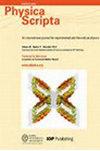基于神经网络代用模型和 XFEM 的裂纹识别方案
IF 2.6
3区 物理与天体物理
Q2 PHYSICS, MULTIDISCIPLINARY
引用次数: 0
摘要
裂缝检测与识别对工程结构的安全问题具有重要意义。本文提出了一种基于扩展有限元和神经网络代理模型的智能裂缝识别方案,以实现裂缝参数的精确识别。该方法首先采用扩展有限元正演分析法获取不同裂缝长度几何模型上测点的位移数据,并将其作为样本数据输入代型模型训练,建立基于神经网络的裂缝识别逆分析模型,利用灰狼优化算法自动更新神经网络的阈值和权值,最终计算出全局最优结果。在代用模型的筛选方面,本文通过对比分析神经网络、支持向量机和其他代用模型的特点,验证了神经网络代用模型在数据拟合和裂纹信息提取方面的优势,并采用灰狼优化算法对神经网络代用模型进行了优化。最后,给出了几个不同类型裂纹的数值实例来验证所提方法的有效性,结果表明所提方法能准确反演裂纹的几何信息。本文章由计算机程序翻译,如有差异,请以英文原文为准。
A crack identification scheme based on neural network surrogate model and XFEM
Crack detection and identification is of great significance to the safety issues of engineering structures. In this paper, an intelligent crack identification scheme based on extended finite element and neural network surrogate model is proposed to realize the accurate identification of crack parameters. The method firstly employs extended finite element forward analysis to obtain the displacement data of measurement points on geometric models with different crack lengths, and inputs them as sample data to train the agent model, establishes a neural network-based inverse analysis model for crack identification, and automatically updates the threshold and weight of the neural network by using the Gray Wolf optimization algorithm to finally compute the globally optimal results. In the screening of the surrogate model, this paper verifies the advantages of the neural network surrogate model in data fitting and crack information extraction by comparing and analyzing the characteristics of neural network, support vector machine and other surrogate models, and optimizing the neural network surrogate model by adopting the Gray Wolf optimization algorithm. Finally, several numerical examples of different types of cracks are given to verify the validity of the proposed method, and the results show that the proposed method can accurately invert the geometric information of cracks.
求助全文
通过发布文献求助,成功后即可免费获取论文全文。
去求助
来源期刊

Physica Scripta
物理-物理:综合
CiteScore
3.70
自引率
3.40%
发文量
782
审稿时长
4.5 months
期刊介绍:
Physica Scripta is an international journal for original research in any branch of experimental and theoretical physics. Articles will be considered in any of the following topics, and interdisciplinary topics involving physics are also welcomed:
-Atomic, molecular and optical physics-
Plasma physics-
Condensed matter physics-
Mathematical physics-
Astrophysics-
High energy physics-
Nuclear physics-
Nonlinear physics.
The journal aims to increase the visibility and accessibility of research to the wider physical sciences community. Articles on topics of broad interest are encouraged and submissions in more specialist fields should endeavour to include reference to the wider context of their research in the introduction.
 求助内容:
求助内容: 应助结果提醒方式:
应助结果提醒方式:


